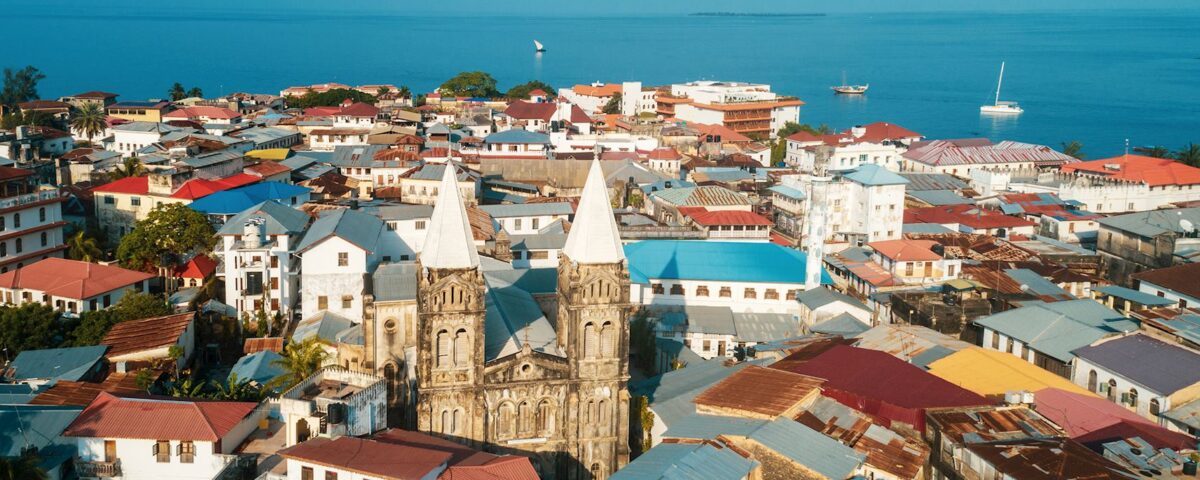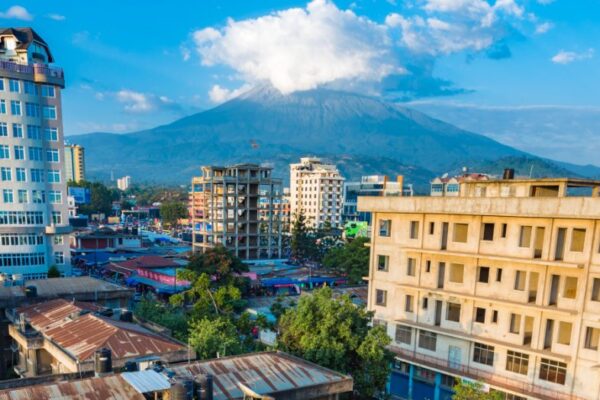
Jinja : Adventure Meets Chill in Uganda’s Riverside City
April 29, 2025
Urban Safari: Wildlife Encounters in Arusha City
April 29, 2025Exploring Dar es Salaam and Stone Town Like a Local
Experience Tanzania not just as a tourist, but as a local adventurer. From the buzzing streets of Dar es Salaam to the ancient alleys of Stone Town in Zanzibar, this guide takes you deep into the culture, history, and everyday life of two of Tanzania’s most vibrant locations. Join us as we explore the real essence of Tanzanian life through the eyes of the people who live it.
Dar es Salaam by Dala-Dala: Experience City Life Like a Local
What Is a Dala-Dala?
To truly experience the heartbeat of Dar es Salaam, hop aboard a dala-dala—the city’s most popular form of public transport. A dala-dala is a privately owned minibus or van, usually packed to capacity with friendly locals commuting to work, school, or market. These minibuses operate along fixed routes and are an affordable and authentic way to explore the city.
While not the most luxurious way to get around, dala-dala offer an unfiltered view of daily life in Dar. For less than 1,000 Tanzanian shillings (under $0.50 USD), you can ride alongside street vendors, students, and workers, listening to Bongo Flava music blaring from speakers, and catching snippets of Swahili conversations. The experience is raw, sometimes chaotic, but always lively.
Busting Through Bustling Markets

Kariakoo Market
Begin your city adventure at Kariakoo Market, Dar es Salaam’s largest and busiest marketplace. Accessible via several dala-dala routes, Kariakoo is a maze of stalls selling everything from fresh produce and second-hand clothing to electronics and household goods. Here, you’ll witness the vibrant commerce that fuels Dar’s economy.
Walk through narrow lanes where vendors shout prices and customers bargain energetically. Smells of ripe mangoes, grilled corn, and fried fish float in the air. This is the perfect spot to buy local fabrics (kitenge), souvenirs, and spices. But more importantly, it’s a place to observe the rhythm of local trade and community.
Afterward, hop back on a dala-dala toward Mwenge Carvers Market, a hub for Tanzanian crafts. Here, artisans carve intricate wooden sculptures, paint colorful Tinga Tinga artworks, and create jewelry from recycled materials. Watching these artists at work is a cultural experience in itself.
A Coastal Ride to Kigamboni Beach

No trip to Dar es Salaam is complete without a stop at the Kigamboni Peninsula, a serene beach escape just across the harbor. Board a dala-dala heading toward the Kivukoni Ferry Terminal, and enjoy a short ferry ride with panoramic views of the Indian Ocean and the city skyline. From the other side, another dala-dala or motorbike (boda-boda) can take you to South Beach (Kipepeo).
Kigamboni offers a more relaxed side of Dar es Salaam. White sands, swaying palms, and fresh seafood shacks await. Here, you can unwind after the bustle of city life, interact with beachside vendors, or even join a local soccer match on the sand. It’s the perfect combination of urban adventure and seaside serenity.
Historical Touchpoints: From Askari Monument to the National Museum

Askari Monument
While dala-dala zip through modern traffic, Dar also boasts deep historical roots. Disembark near Askari Monument, a tribute to African soldiers who served in World War I. Just a short walk away lies the National Museum of Tanzania, where you can dive into the country’s colonial history, ancient fossils, and cultural heritage.
Another highlight is the Azania Front Lutheran Church, a 19th-century German landmark that offers a peaceful view of the harbor. These sites give you a chance to reflect on Tanzania’s journey from colonial rule to independence.
Exploring Dar es Salaam by dala-dala is not just a way to get around—it’s an immersive journey into the everyday life, history, and heart of the city. It’s where chaos meets charm, and where every ride becomes part of the story.
Swahili Secrets: Discovering the Hidden History of Stone Town, Zanzibar
An Ancient Labyrinth with Stories in Every Corner
Across the Zanzibar Channel lies Stone Town, the cultural soul of Zanzibar Island. This UNESCO World Heritage Site is a maze of narrow alleyways, ornate wooden doors, crumbling coral-stone buildings, and hidden courtyards. Walking here feels like stepping back in time.
Start your journey at Darajani Market, the town’s commercial heartbeat. The scent of fresh spices—cardamom, cloves, cinnamon—wafts through the air. Fishmongers, butchers, and fruit vendors line the stalls, while locals shop for daily essentials. It’s vibrant, noisy, and alive.
Wander on toward Kenya Street and beyond, where alley cats roam ancient corridors and schoolchildren chatter in Swahili. Unlike Dar’s open spaces, Stone Town wraps you in intimacy. Every corner offers a glimpse into Swahili life, with influences from Arab, Persian, Indian, and European cultures embedded in the architecture and daily routines.
The Spice Trail: Tasting the Island’s Famous Flavors

Zanzibar isn’t called the “Spice Island” for nothing. Spice tours are a must-do, but even within Stone Town, you can explore the island’s spice heritage. Head toward Spice Market Square, and you’ll find locals selling vanilla pods, turmeric roots, cloves, and nutmeg straight from the farms.
Try street-side delicacies like Zanzibar pizza—a savory-sweet snack with meat, egg, cheese, and vegetables folded into a thin dough and grilled. Or sip a cup ginger-infused delight, while watching the sunset from the rooftop of Emerson on Hurumzi or the Tea House Restaurant.
Historic Sites: From Slave Market to Sultan’s Palaces

House of Wonders (Beit al-Ajaib)
Stone Town’s beauty is shadowed by a painful history. One of the most important stops is the Old Slave Market, now home to the Anglican Cathedral of Christ Church. Beneath the church are chambers where enslaved people were held before being sold. The site is sobering and essential—a reminder of Zanzibar’s role in the Indian Ocean slave trade.
Not far away stands the House of Wonders (Beit al-Ajaib), once the tallest building in East Africa and the first to have electricity and an elevator. Though currently under restoration, it remains a symbol of Zanzibar’s cosmopolitan past. Nearby, you’ll find the Old Fort, a 17th-century Omani structure now housing artisan shops and cultural performances.
Doors That Tell Stories: The Art of Swahili Architecture

Zanzibar’s iconic carved wooden doors
As you walk the alleyways, you’ll notice Zanzibar’s iconic carved wooden doors—each one a masterpiece of design and symbolism. There are two main types: the Arab-style with intricate inscriptions and geometric patterns, and the Indian-style with brass studs originally used to deter elephants. These doors are more than entryways—they represent family status, heritage, and cultural pride.
Some doors bear dates and Arabic script that reflect the year they were built or quotes from the Quran. Take a walking tour with a local guide to decode these fascinating symbols and learn the stories they silently hold.
Evening on the Waterfront: Forodhani Gardens

Zanzibar Street Food
As the sun dips into the Indian Ocean, head to Forodhani Gardens, the town’s seaside promenade. Every evening, the park transforms into a bustling night food market. Vendors set up stalls offering skewers of seafood, grilled meats, sugarcane juice, samosas, and octopus on a stick. The air buzzes with laughter, sizzling grills, and the scent of Zanzibar’s culinary fusion.
Locals gather here for an evening walk, kids perform acrobatic flips into the sea, and tourists and residents dine under the stars. It’s a place of joy, food, and community spirit—the perfect way to end a day of exploration.
Final Thoughts: Embrace the Local Way of Life
Tanzania is more than game drives and beaches—it’s alive with stories, cultures, and connections. By riding a dala-dala through Dar es Salaam or walking the winding streets of Stone Town, you tap into the heartbeat of the nation.
These experiences don’t require five-star hotels or luxury tours. All they demand is curiosity, respect, and a willingness to explore. Whether it’s squeezing onto a crowded minibus or deciphering the language of carved doors, you’ll find that the most meaningful adventures often lie off the beaten path.
At Traford Safaris Ltd, we believe in travel that connects you to people and places on a deeper level. Let us help you explore Tanzania beyond the guidebooks—where stories are shared over spice-scented air, and every street corner has a history waiting to be told.





